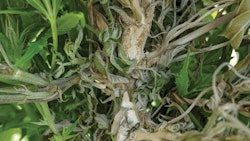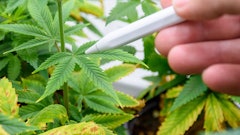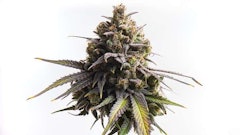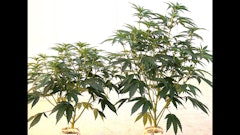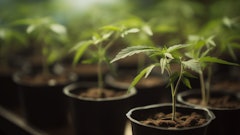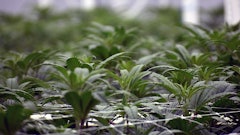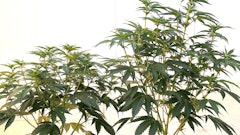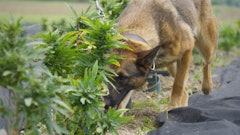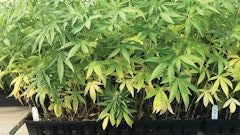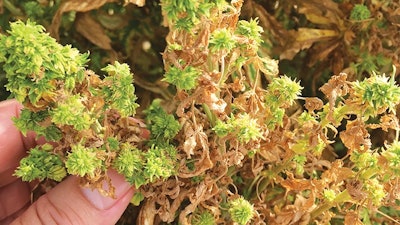
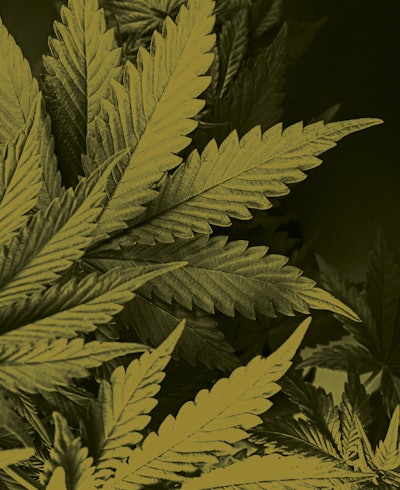
Cannabis sativa is the species comprising hemp (which is bred for fiber, seed and/or oil) and marijuana (which possesses tetrahydrocannabinol (THC)). Both varieties share many of the most common and serious diseases that can result in significant production loss.
Due to different growing environments (outdoor versus a controlled environment), hemp crops may have more exposure to disease agents than marijuana plants. Unfortunately, there is little pathology work done on Cannabis sativa crops, and many problems are not even diagnosed, let alone diagnosed properly. Below are diseases the Nevada Department of Agriculture (NDA) plant pathology laboratory has detected, as well as best practices for field scouting and disease management.
Diseases Caused by Fungi and Oomycetes
Fungi are the most common pathogens that infect many plant species. They produce mycelium (white filaments) and/or spores, and some produce special structures for winter survival and dissemination. Plants infected by fungal pathogens may exhibit symptoms of leaf spots, mildew, blight (more extensive browning or sudden death), wilt, canker or root rot, all of which can turn lethal. Oomycetes are fungus-like organisms such as Phytophthora and Pythium that commonly cause various diseases on plants, including on Cannabis sativa.
Fusarium wilt (Fusarium oxysporum and F. solani)
Fusarium wilt is a destructive disease on Cannabis sativa plants. The fungi, Fusarium oxysporum and/or F. solani, infect vascular tissue, causing plant wilt and death. When infection progresses systemically, pathogens can be passed from mother plants to cuttings. Infected plants can exhibit poor growth, may be unresponsive to added nutrients or fertilization, and can wilt even with adequate soil moisture.
- Diagnostic characteristics: Vascular tissue turning dark brown. A cross or longitudinal section of the basal or lower stem often reveals the vascular browning.
- Prevention/Treatment: The fungi survive in soil, growing media or dead plant tissue, and the disease may persist for years if not treated. Therefore, prevention is the best management practice for this disease. For marijuana crops, mother plants should be kept healthy and free from Fusarium infection through periodic monitoring and testing. (Most plant pathology labs at university extensions can do these tests. NDA’s plant pathology lab only accepts samples from Nevada.) Once mother plants, cuttings and/or growing media are found to be infected, they should be destroyed, and affected areas should be thoroughly disinfected with a bleach solution to prevent spread. For hemp crops, a field free of Fusarium diseases should be selected. If Fusarium wilt occurs in the first hemp crop, it is highly recommended to rotate with other Fusarium-resistant crops to mitigate disease pressure by starving the fungi.
Fusarium stem canker (Fusarium spp.)
Some Fusarium species cause stem canker or stem rot, in addition to vascular wilt. Two species, F. oxysporum and F. solani, are found to be associated with stem canker disease on hemp.
- Diagnostic characteristics: Affected plants exhibit dark lesions or cankers on stems, and white mold is often found on the surface of cankered areas. Internal tissue of stems may rot.
- Prevention/Treatment: Stem canker has more extensive infections on branches and non-vascular tissue, whereas vascular wilt is more restricted in vascular tissue, causing systemic wilt. Fusarium stem canker has not been observed on marijuana plants. Like the management practice for Fusarium wilt disease, the best way to avoid stem canker disease is to select a field that has not been cultivated with a Fusarium-susceptible crop (tomato, melon, sweet potato, etc.).
Fusarium root rot (Fusarium spp.)
Fusarium root rot is a destructive disease on hemp but is not seen in marijuana. Several Fusarium species, namely F. oxysporum, F. solani, F. redolens, F. tricinctum and F. equiseti, contribute to this disease.
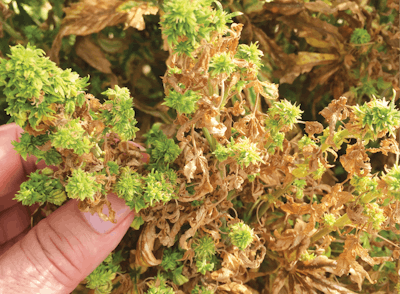
Pythium crown and root rot (Pythium aphanidermatum)
Pythium aphanidermatum, a pathogen belonging to the oomycetes, attacks hemp crops, causing damping off in the seedling stage or death of plants during the season.
- Diagnostic characteristics: Early infection signs include mild leaf yellowing, curling or necrosis (death of plant cells) along the edge. Plants may wilt temporarily in warmer temperatures. Examining the crown area of the stem may reveal necrotic lesions and internal discoloration (visible by cross section). As the disease progresses, lesions or cankers will expand at the basal stem and infection may spread from the crown area upward to the main stem and lower branches, eventually killing the plant.
When scouting, look for water-soaked lesions and cankers around the basal stem when a plant starts to show foliar symptoms. A canker where the stem meets the soil line is the most diagnostic symptom for Pythium crown rot. During the late season, grayish to white-colored mold (Pythium mycelium) may be visible on the surface of the crown area. This pathogen can cause severe root rot in certain conditions; however, it appears to be more aggressive on crown and stem tissue, especially if the soil surface is covered by plastic mulch.
- Treatment: Removing mulch helps reduce soil moisture and disease incidence temporarily, but it may not stop the disease development in plants that have already been infected. A best practice to eliminate or reduce the disease is to treat seeds with approved fungicides or a diluted bleach solution.
Powdery mildew
Powdery mildew fungi are a group of widespread, well-known obligate fungal pathogens that negatively impact a diverse array of host plants in a variety of environmental conditions. Cannabis sativa plants grown indoors are prone to powdery mildew, and due to the difficulty of eradication and limited products approved for Cannabis, the disease can be troublesome to control. Specific fungal species causing powdery mildew on Cannabis are not fully known, but in one marijuana cultivation facility, the powdery mildew fungus was preliminarily found to be closely related to Golovinomyces ambrosiae. In Kentucky, Golovinomyces sp. was reported to cause powdery mildew on hemp. This is a significant finding because knowing the pathogen’s species will help develop solutions for effective treatment and management.
- Diagnostic characteristics: Powdery mildew is easily identified on plants: It produces patches of grayish white, powder-like fungal mycelium and spores on leaf surfaces. Fungal spores may be carried by air currents and disseminated inside a cultivation facility through air circulation.
- Treatment: Powdery mildew is considered treatable; however, treatment options for Cannabis may be limited. As such, once an infection takes hold, eradication of this fungus from the facility is recommended. Removing infected plants as soon as they are noticed and sanitizing the infected area with a diluted bleach solution or other disinfectants can help eradicate early infection and stop the disease from spreading.
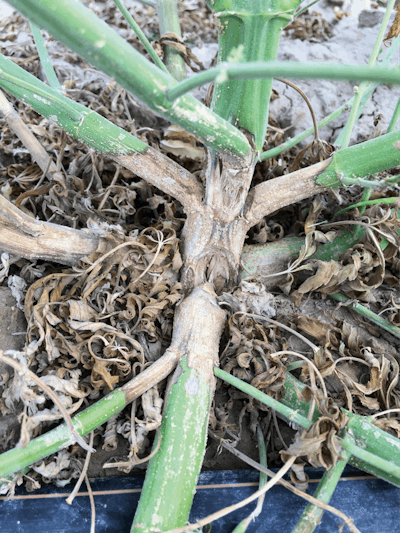
Latent fungal infection in seeds
Cannabis seeds may carry some fungal pathogens with or without visible seed damage. Some fungi may infect Cannabis seeds, causing poor germination or affecting viability of seedlings. Some imported hemp seeds are found to be infected by species of Alternaria, a genus of fungi considered to be ubiquitous, opportunistic pathogens. Although they are frequently associated with hemp seeds, their impact on seeds and plant health is unknown. Another fungus frequently isolated from hemp seeds is Rhizopus, a fungus that causes fruit rot on other crops. Infection of hemp seeds by Rhizopus may impact seed germination and seedling health, but there is no experimental data to prove it.
- Diagnostic characteristics: Close examination of individual seeds may reveal some fungal mycelium growth during the routine germination test.
- Treatment: Treating seeds with a protective and approved fungicide or diluted bleach solution was found to improve seed germination and crop success. State extensions can also test seeds for pathogens.
Disease Caused by Bacteria
Bacteria are microscopic, single-celled organisms. Most bacteria are culturable on artificial nutrient media and cause soft rot (decomposed plant tissue), fire blight (“scorched” lesions), wilt or root rot.
There is a group of bacteria that is not culturable on nutrient media called fastidious prokaryotes. Phytoplasmas are one type of fastidious bacteria that live in phloem sieve tubes of live plants and are transmitted by insect vectors. Typical symptoms of fastidious prokaryotes include witches’ broom, systemic yellowing, stunting, chronic decline and abnormal growth.
Phytoplasma witches’ broom
Hemp is prone to phytoplasma infection, and once infected, plants exhibit severe witches’ broom-like symptoms.
Diseases Caused by Viruses
Viruses are submicroscopic particles made up of protein and nucleic acid. They infect plant cells and use the plant’s nucleic acid replication systems to produce more viruses to interfere with plant growth. Common symptoms caused by viruses are leaf mosaic, twisting, distortion, chlorosis, yellowing, necrosis, stunting or death.
Cannabis mosaic and leafroll
Leaf mosaic and other virus-like symptoms have been observed on both marijuana and hemp crops. These symptoms suggest viral infections, but no specific virus has been detected. Some cannabis growers consider tobacco mosaic virus (TMV) to be the culprit, but lab tests in Nevada were negative in several cases.
- Diagnostic characteristics: Leaf mosaic, twisting, distortion, chlorosis, yellowing, necrosis, stunting or death. Another virus-like symptom on Cannabis crop is leaf curling. Curled leaves appear yellowish or light green and feel coarse to the touch. It is unknown if this symptom is caused by a type of virus (such as potato leafroll) causing leafroll symptoms. Both mosaic and leafroll may occur on the same plant, suggesting dual infections. We have no formal report of leafroll virus in Cannabis.
- Prevention/Treatment: Viral diseases on Cannabis sativa are difficult to treat, and limited treatment products are available. Most viruses are transmitted by insect vectors, so monitoring and controlling insects is key to mitigating virus infections in the field. For indoor Cannabis cultivation, it is recommended to frequently wash hands with soap to prevent the introduction of TMV and other viruses.









